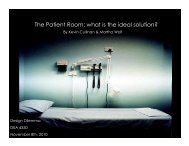The role of physical design and informal communication
The role of physical design and informal communication
The role of physical design and informal communication
You also want an ePaper? Increase the reach of your titles
YUMPU automatically turns print PDFs into web optimized ePapers that Google loves.
extraordinary opportunity to apply the findings <strong>of</strong> research aimed at improving the<br />
quality <strong>of</strong> healthcare’s <strong>physical</strong> environment.<br />
1.2 Evidence-Based Design<br />
<strong>The</strong> current boom in the construction <strong>of</strong> hospitals is a reaction to the existing<br />
condition <strong>of</strong> the healthcare environment in the U.S. New facilities are needed to<br />
replace the outdated “Hill-Burton era” buildings <strong>of</strong> the mid 20 th century <strong>and</strong> will<br />
address issues such as the nursing shortage, the rising expectations <strong>of</strong> consumers, the<br />
aging <strong>of</strong> baby boomers, advancements in information <strong>and</strong> medical technology, <strong>and</strong> the<br />
increase in life expectancy. Occurring alongside this transformation <strong>of</strong> the industry<br />
<strong>and</strong> its consumers is public concern for the shockingly high prevalence <strong>of</strong> medical<br />
errors in U.S. hospitals reported by the Institute <strong>of</strong> Medicine (IOM) in To Err is<br />
Human: Building a Safer Health System (1999). This report <strong>and</strong> others like it (IOM,<br />
2001; IOM, 2003) have revealed the fact that hospitals are needlessly unsafe <strong>and</strong><br />
stressful for both patients <strong>and</strong> staff.<br />
<strong>The</strong> construction boom presents hospital executives <strong>and</strong> architects with an<br />
opportunity to embrace the practice <strong>of</strong> using evidence-based <strong>design</strong> – “a deliberate<br />
attempt to base <strong>design</strong> decisions on the best available research findings” (Hamilton,<br />
2004). Thanks to advocacy from the Center for Health Design, there is a growing<br />
respect for the idea that a carefully considered <strong>and</strong> well-<strong>design</strong>ed healthcare<br />
environment - based on the findings <strong>of</strong> research - can have a positive impact on the<br />
well-being <strong>of</strong> patients <strong>and</strong> staff. <strong>The</strong> Center for Health Design is promoting the use <strong>of</strong><br />
evidence-based <strong>design</strong> to create healing environments through a pioneering initiative<br />
known as the Pebble Project. <strong>The</strong> goal <strong>of</strong> this project is to provide documented<br />
examples <strong>of</strong> how using evidence-based <strong>design</strong> can improve the quality <strong>of</strong> care as well<br />
as financial performance (<strong>The</strong> Center for Health Design, 2006). To date, a collection<br />
2







